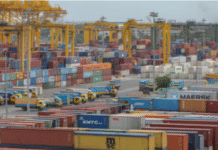
The persistent dollar crisis in Bangladesh has exacerbated various economic issues, including inflation, rising business costs, an energy crisis, and mounting government foreign debt payments.
Bankers say that commercial banks in the country are having difficulty opening Letters of Credit because their holdings of foreign currency are evaporating rapidly.
In April, foreign currency reserves held by commercial banks fell to a 14-month low of $5,047 million, down from $5,439 million in March and $5,559 million in December 2023. This is the lowest level since January 2023, when reserves were $4,849 million.
Against the backdrop, banks received little support from the central bank, whose own foreign reserves are also dwindling, making it harder for banks to open LCs for importing essential products.
Many import payments have been delayed or renegotiated due to the dollar shortage, leaving banks desperate to acquire the necessary foreign currencies.
The country’s foreign currency reserves, according to International Monetary Fund guidelines, dropped to $18.2 billion in May 2024 from $48 billion in August 2021.
To mitigate the depletion, the government has secured a $4.7 billion loan deal from the IMF.
On May 8, the central bank devalued the local currency from Tk 110 to Tk 117 per US dollar.
However, many banks are selling dollars at Tk 120–123 for opening LCs. This devaluation follows a series of declines from Tk 94.7 in July 2022 and Tk 84.8 in July 2021.
Bangladesh, like many other countries, has foreign debt denominated in US dollars. As the taka depreciates, it will take more taka to repay the same amount of foreign debt in dollars.
It can lead to higher debt repayment obligations for the government and businesses, putting further strain on their finances, economists said.
Mohammad Hatem, executive president of the Bangladesh Knitwear Manufacturers and Exporters Association (BKMEA), said that the persistent dollar crisis has forced banks to decline opening LCs.
As a result, the import of raw materials has been delayed or obstructed, significantly reducing business production.
He added that hampered imports have led to reduced production and increased product prices due to supply constraints.
Hatem urged the government to provide policy support and take measures to avoid some of the IMF›s conditions, which he believed were detrimental to the industrial growth of the country.
The government has been struggling to make significant foreign payments, particularly in the energy sector.
Payment arrears to India›s Adani Group for power purchases have increased to $700 million.
Additionally, some foreign companies have been unable to repatriate their earnings due to the dollar crunch.
During a recent visit, US State Department Assistant Secretary for South and Central Asia, Donald Lu, expressed concerns about the dollar shortage affecting US companies› ability to remit profits from Bangladesh.
United International University professor Mohammad Musa told New Age that the current dollar crisis was unlikely to ease soon, despite the government›s efforts to stabilise the market.
He mentioned that although an increase in the dollar rate may lead to immediate inflationary pressure, the government should devalue the currency to its actual rate to attract exports and foreign remittances.
He suggested the central bank raise the dollar rate gradually to minimise the impact on inflation.
Businesses are feeling the impact of the sharp rise in the dollar rate, with import costs increasing by 7 per cent, making them hesitant to open LCs.
This increased cost is often passed on to consumers, leading to higher prices for goods and services, reducing consumers’ spending and purchasing power.
The Bangladesh Bureau of Statistics recorded headline inflation of 9.81 per cent in March, compared to 9.67 per cent in the previous month. The inflation rate has remained above 9 per cent since March 2023.
Bangladesh Textile Mills Association (BTMA) president Mohammad Ali Khokon criticised the Bangladesh Bank for its lack of control over scheduled banks, which, he said, were demanding higher dollar rates for opening LCs.
While BB set the dollar rate near Tk 118, banks are charging around Tk 123–125 for opening LCs, significantly increasing business costs.
Many businesses are reluctant to open LCs due to the substantial gap between the dollar rate they receive from exports and the rate required for importing raw materials, Khokon added.
Economists attribute the ongoing dollar crisis to several factors, including a significant gap between supply and demand for dollars, declining foreign exchange reserves, poor remittance inflows, and low export earnings.
The dominance of the informal ‹hundi› market, where unofficial currency trading occurs, exacerbates the situation.
In an attempt to stabilise the market, the central bank has sold more than $32.8 billion to commercial banks over the past 34 months, including $11.67 billion in July-April of FY24, $13.5 billion in FY23, and $7.62 billion in FY22.
These sales have reduced the central bank›s reserves and created a liquidity crisis in the banking sector.
Syed Mahbubur Rahman, managing director of Mutual Trust Bank, told New Age that banks are now more cautious and restrict LC openings to avoid payment difficulties.
He hoped that the dollar crisis might improve after the rate hike, which could reduce the gap between formal and informal remittance channels.
However, he warned that a sudden dollar hike could increase inflation.
Remittances and export earnings are prime tools for bankers to meet the demand for dollars, but both are falling, the BB officials said.
New Age









